Each year, the New Zealand Book Awards for Children and Young Adults make for a massive occasion in the Aotearoa kids’ book world—move over Oscars, out of the way Silver Scrolls. This is our night. Well, nearly. Awards night isn’t until August, but between now and then we are looking forward to sharing a closer look at the authors and illustrators behind the best books of the year. Each week we will cover a different category, so stay tuned!
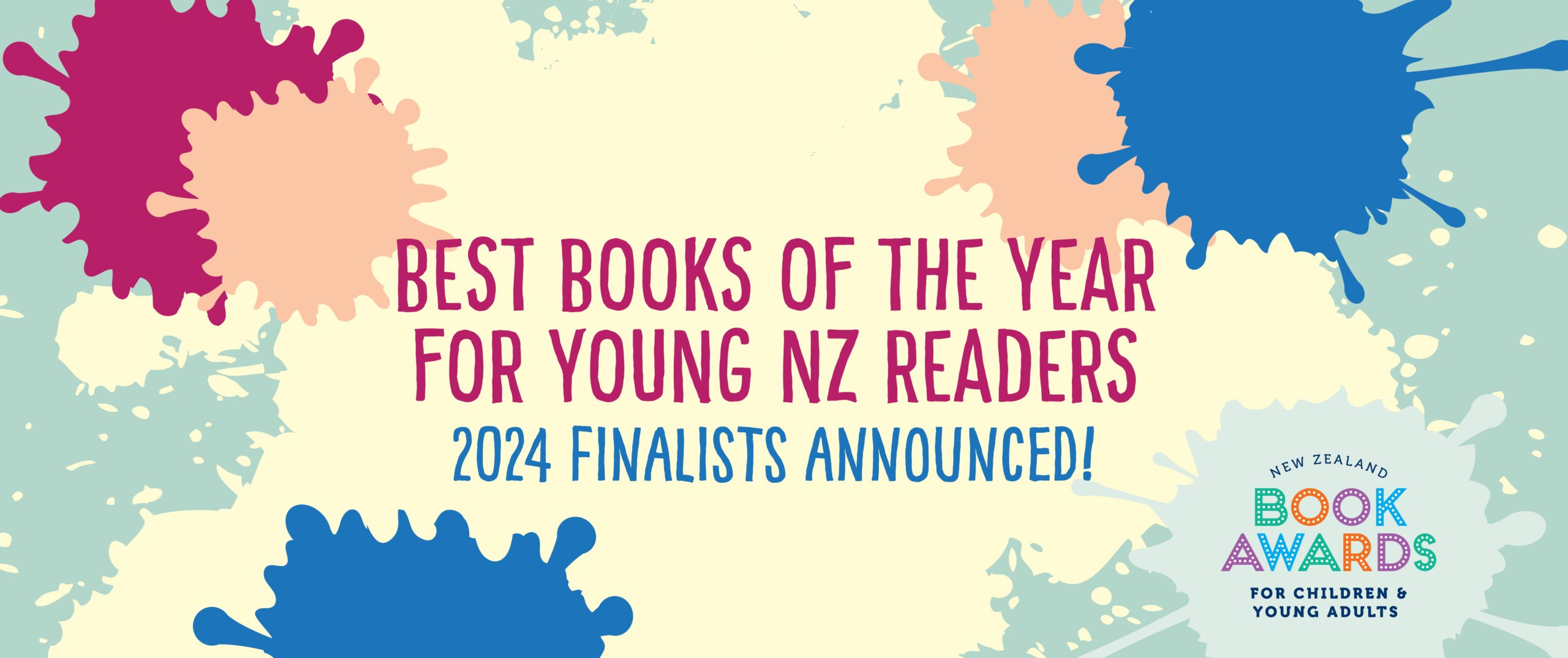
As I was writing about the shortlisted books I wondered how one can compare such different pieces of work? Each book in its own right has power over a reader, and the ‘best’ book for one reader will not be the ‘best’ book for another.
But what is great about these shortlisted titles, and all of New Zealand’s children’s literature published last year, is its breadth and richness. Our books reach across types of genres, stories, themes, histories, and knowledge. It’s the perfect example of the whole being greater than the sum of its parts. And while there are certainly some especially excellent titles out there that we should recognise, it’s the whole canon that we should be proud of. For all that our reviewers and I have strong opinions on what we like or think is important in children’s books, Aotearoa is making a lot of pukapuka that kids love to read. These awards are a celebration of just some of the best books, because all the books out there are a best book for someone. Onto the shortlists!
Picture Book Award Finalists
- At the Bach, written by Joy Cowley and illustrated by Hilary Jean Tapper (Gecko Press)
- Dazzlehands, written by Sacha Cotter and illustrated by Josh Morgan (Huia Publishers)
- Hatch and Match, written and illustrated by Ruth Paul (Walker Books Australia)
- Lucy and the Dark, written by Melinda Szymanik and illustrated by Vasanti Unka (Penguin Random House)
- Paku Manu Ariki Whakatakapōkai, written by Michaela Keeble and illustrated by Tokerau Brown (Gecko Press)

What a line-up! We’ve got At the Bach, which is sure to become a Joy Cowley classic, a glittering masterpiece in Dazzlehands, a tale of befriending your fear in Lucy and the Dark, wonderful rhymes and colourful match-ups in Hatch and Match, and an intriguing foray into the mind of a child in Paku Manu Ariki Whakatakapōkai. Cowley’s At the Bach has just seen a second release as Good Night, Good Beach, in time for the Northern hemisphere summer, Dazzlehands is to be performed as a ballet, these two plus Lucy and the Dark were named Storylines Notable Books last year, and Paku Manu Ariki Whakatakapōkai is a finalist in three categories!
What I love about the selections in this category—and, in fact, picture books in general—is the way they encompass different ways of appreciating reading and what we get out of it. Through these pukapuka we get what feels like a nostalgic Kiwi version of Goodnight Moon, a salute to being our dazzling selves, a light-hearted take on the dark, an audience-interaction-required hunt for chickens, and an insight into the mind of a child. Between them they are fun, earnest, and perceptive. They are all incredible books. My pick for the winner is the one that most pushes the boundary of what we see in children’s books, and in doing so gives huge respect to the reader: Paku Manu Ariki Whaktakapōkai.
Wright Foundation Esther Glen Junior Fiction Award Finalists
- DoubleDippers! (Big Little Blue, Book #3), written and illustrated by Raymond McGrath (Scholastic NZ)
- Lopini the Legend, by Feana Tu‘akoi (Scholastic NZ)
- Nine Girls, by Stacy Gregg (Penguin Random House NZ)
- Take Me To Your Leader, by Leonie Agnew (Penguin Random House NZ)
- The Grimmelings, by Rachael King (Allen & Unwin)

A tricky category where junior fiction covers both junior and middle grade fiction. We’ve got sweet penguin friends, school kids faking UFO sightings, a superseded kapa haka leader, an Aotearoa history adventure, and the dark legacy of a kelpie. It’s great to see a graphic novel (DoubleDippers!) getting attention, colonisation and land wars as part of the narrative (Nine Girls; I loved this interview with Stacy Gregg), and Scottish mythology in a New Zealand setting (The Grimmelings). Lopini the Legend is true to Feana Tuʻakoi’s kaupapa of writing stories with kids like hers represented, and Take Me To Your Leader intertwines a tale of family, friends, and grief with a delightful tale of how to save a rural school with a touch of the uncanny.
I’m picking The Grimmelings as winning over the judges for this one.
Young Adult Fiction Award Finalists
- Catch a Falling Star, by Eileen Merriman (Penguin Random House NZ)
- New Dawning, by A. M. Dixon (OneTree House)
- The Sparrow, by Tessa Duder (Penguin Random House NZ)
- Tonight, I Burn, by Katharine J Adams (Hachette Aotearoa NZ)
- Tsunami, by Ned Wenlock (Earth’s End Publishing)
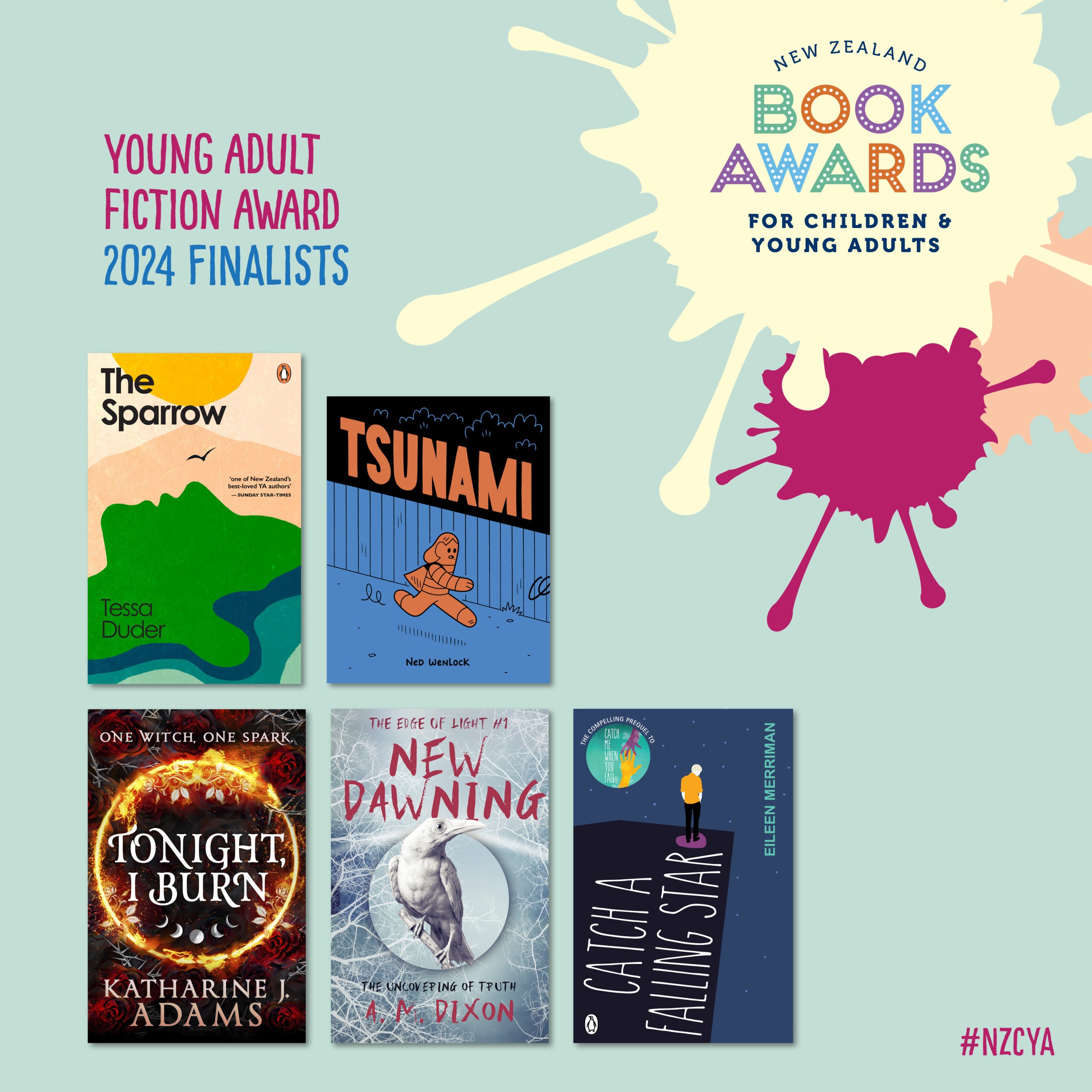
I love seeing debut authors up against multi-published, multi-award winning authors. I mean it’s probable no-one wants their book to come out in the same year as a book by Tessa Duder—but it shows that well-published authors and authors newer to the scene are each writing stories that are current, engaging, and worth rewarding. Duder needs no introduction I’m sure, and Eileen Merriman has put out an impressive body of work over the past 10 or so years. Ned Wenlock has been making comics for who knows how long, and while this may be their first books, I have no doubt Katharine J. Adams and A. M. Dixon have been writing for much longer.
Catch a Falling Star is the prequel to Merriman’s Catch Me When You Fall, and is a love story intertwined with illness and mental health. New Dawning is the first in a new trilogy, set in a dystopian future with a controlling government. The Sparrow is historical fiction set in 1840 based on the lives of British women convicts taken to Australia. Tonight, I Burn is a gothic fantasy, set in a time where witches are burned at the stake. Tsunami, a graphic novel, is a story of bullying and growing up, set in the most Nyew Zulland of New Zealands. Each tackles a different kind of grimness.
Although I would love to see a graphic novel take the prize, this year, I think The Sparrow will be the one to take flight.
Elsie Locke Non-Fiction Award Finalists
- Patu: The New Zealand Wars, written and illustrated by Gavin Bishop (Penguin Random House NZ) Read an interview with Gavin, by Simie Simpson.
- The Observologist: A Handbook for Mounting Very Small Scientific Expeditions, written and illustrated by Giselle Clarkson (Gecko Press)
- Tuatara: A Living Treasure, written by Katie Furze and illustrated by Ned Barraud (Scholastic NZ)
- Ultrawild, written and illustrated by Steve Mushin (Allen & Unwin)
- Wot Knot You Got? Mophead’s Guide to Life, (Auckland University Press)
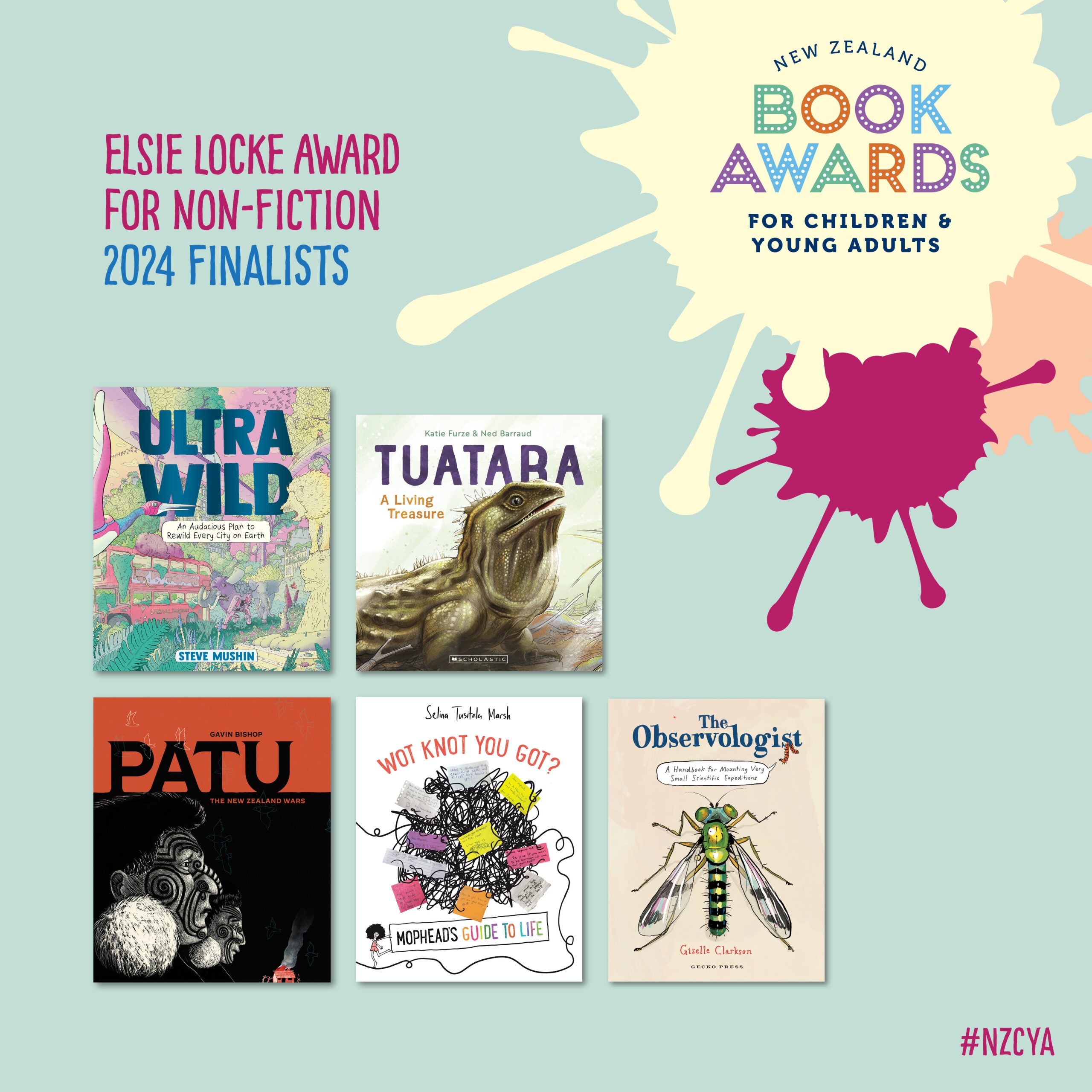
These books are all so amazing for totally different reasons. Nobody will be surprised to see Gavin Bishop’s latest large format taonga, Patu, shortlisted—it is an important national and personal history that doesn’t shy away from the realities of the New Zealand Wars. Giselle Clarkson’s The Observologist is accessible, informative and fun. She writes and draws about exploring nature with a childlike curiosity that is as enticing for adults as for children. Tuatara combines debut author Katie Furze’s lyrical prose with the wonderful illustrative work of Ned Barraud. Ultrawild is, well, ultra wild. Author Steve Mushin has created something so fresh and different: a thought experiment about bringing nature back to cities, in a densely packed book where no idea is too outrageous. Selina Tusitala Marsh brings a third Mophead title to life with Wot Knot You Got?—a self-help style guided journal inspired by real questions from kids—that encourages the reader to write and draw their way to untangling tricky life things.
I love all of these. My personal favourite is The Observologist. But if I had to pick which one I think will win, I would go with Ultrawild. It’s unlike anything else I’ve seen in Aotearoa children’s publishing, and expertly executed with highly engaging pages to pore over for hours. The combination of science, thinking big (enormously, ludicrously big), and its design and production values make for such a fascinating and visually appealing book.
Russell Clark Illustration Award Finalists
- Dazzlehands, illustrated by Josh Morgan (Huia Publishers)
- Paku Manu Ariki Whakatakapōkai, illustrated by Tokerau Brown (Gecko Press)
- Patu: The New Zealand Wars, illustrated by Gavin Bishop (Penguin Random House NZ)
- Samples from the Lab, illustrated by Rob Foote (Creativity Unleashed)
- The Dream Factory, illustrated by Zak Ātea (Huia Publishers)
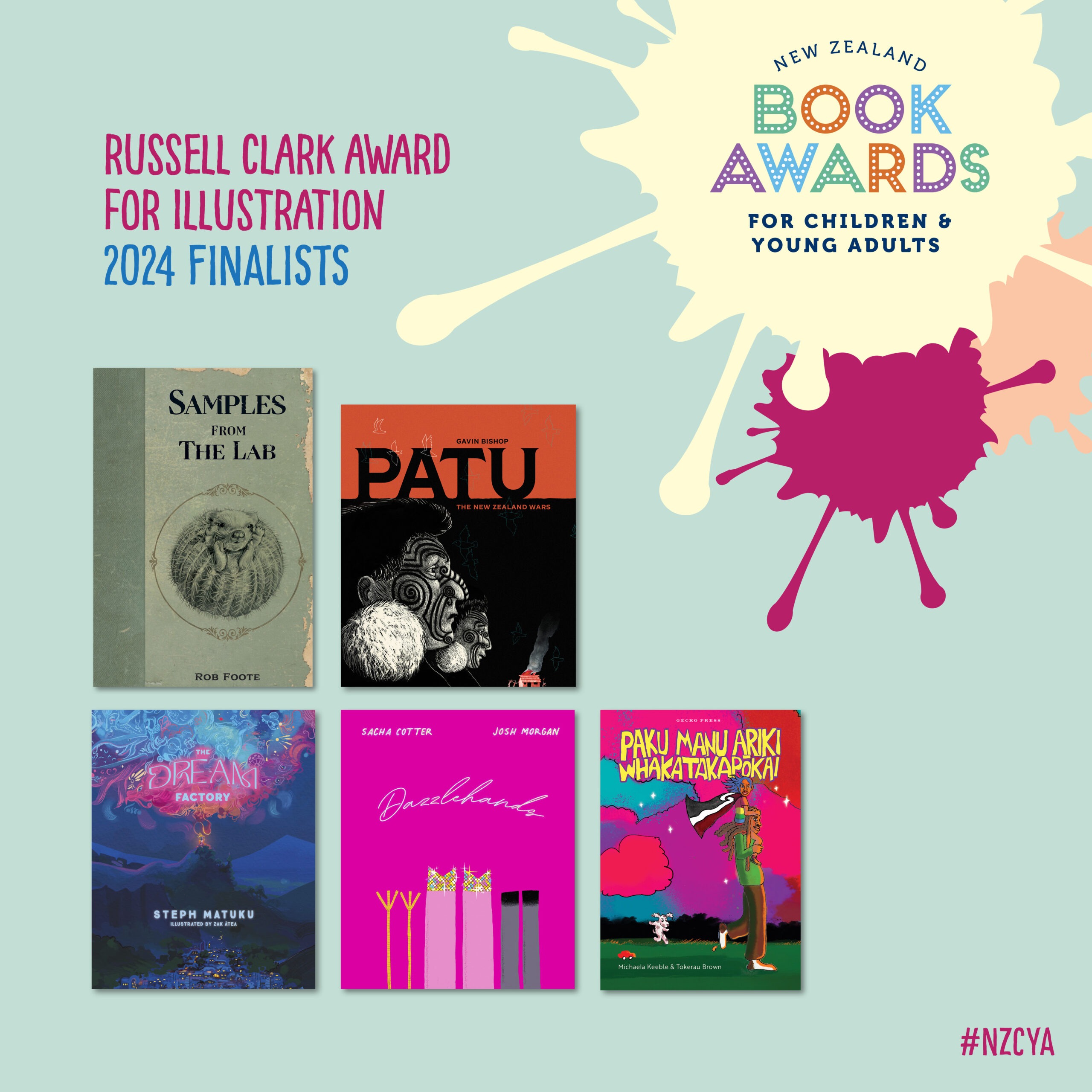
I particularly don’t envy the judges in this category! Five totally different styles accompanying very different narratives. The Dream Factory captured my eye—and heart—immediately with its dreamy, swirling illustrations that are such a perfect match for the story. Dazzlehands definitely dazzles with attention to vibrant colour and judicious use of white space. The style in Paku Manu Ariki Whakatakapōkai appeals least to my personal tastes, but the way the illustrations capture both the written narrative and something deeper is impressive. Samples from the Lab is the only title in the awards I hadn’t previously come across; it’s a delightfully entertaining imagining of a scientist’s lab notes for some very bizarre creatures, which are cute and hilarious—if perhaps a little discomforting. Then there’s Patu. Not to make light of an outstanding portrayal of the New Zealand Wars, but let’s just say Gavin Bishop has done a Gavin Bishop on this material and it is what you would expect, in the best way!
If I had to be choosy (and what is an award for if not to be choosy), I think Patu, Dazzlehands, and Samples from the Lab do the best job of incorporating the illustrations into the design of the page and with the text, which is unsurprising since we’re talking about two author-illustrators and the Cotter-Morgan duo of The Bomb fame. It’s a struggle to narrow it down further, and I’m not sure I can choose between Dazzlehands and Patu, but I think I’m putting my hands up for Dazzlehands.
Wright Family Foundation Te Kura Pounamu Award Finalists
- He Tarū Kahika, written by Melinda Szymanik, illustrated by Isobel Joy Te Aho-White, and translated by Pānia Papa (Scholastic NZ)
- Nani Jo me ngā Mokopuna Porohianga, written by Moira Wairama and illustrated by Margaret Tolland (Baggage Books)
- Te Pīkari Pipi, written by Angie Belcher, illustrated by Lily Uivel, and translated by Pānia Papa (Scholastic NZ)
- Te Pukapuka ka kore e Pānuihia, written by Tim Tipene, illustrated by Nicoletta Benella, and translated by Kanapu Rangitauira (Oratia Media)
- Te Rā Kura Ki Aotearoa, written and illustrated by Donovan Bixley, and translated by Darryn Joseph (Upstart Press)
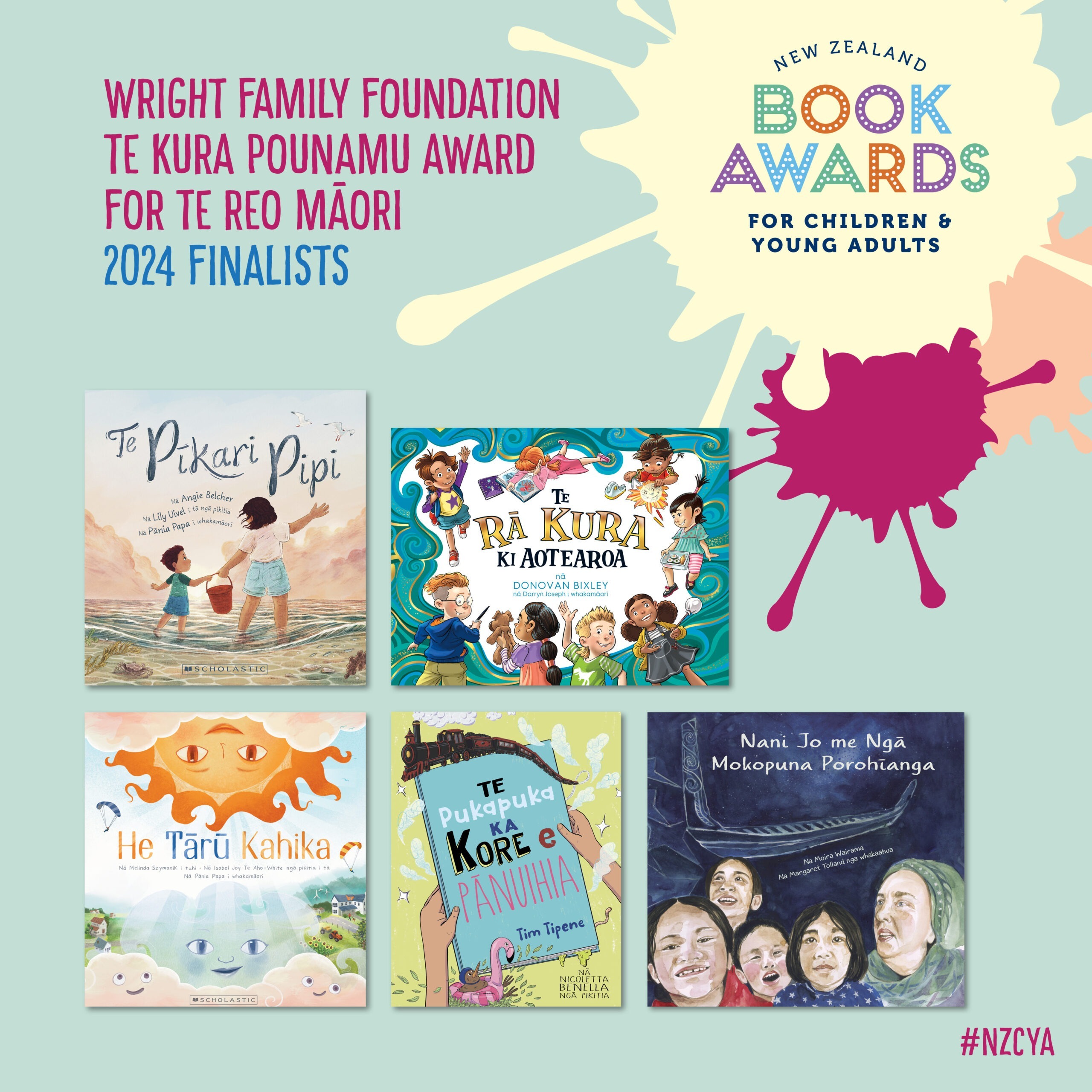
I concede I am not the right person to be having reckons on these pukapuka, and I confess my reo Māori is basic at best so for now I will share a brief summary of the books (based on my reading of the English language versions), and our new te reo editor Faith Tupou will be taking over when we cover this category in greater detail in the coming weeks.
He Tārū Kahika (Sun Shower) tells the story of Rā and Ua avoiding each other and how Kāore thinks they should meet and—spoiler alert!—it eventually happens, resulting in a rainbow. Nani Jo me Ngā Mokopuna Porohīanga (Nanny Jo and the Wild Mokopuna) is about grandmothers—based on a real -life Nani Jo—and saying goodbye, incorporating the customs of Matariki. Te Pīkari Pipi (Pipi Dance) goes through the motions of searching for pipi, dancing to find them, and sharing kai with your whānau. Te Pukapuka ka kore e Pānuihia (The Book That Wouldn’t Read) is the indignation of a child trying to read a book which takes on a life of its own, trying to put the reader off. Te Rā Kura Ki Aotearoa (The Great Kiwi School Day) is what it says on the box, a day in the life of tamariki at kura.
NZSA Best First Book Award Finalists
- New Dawning, by A. M. Dixon (OneTree House)
- Paku Manu Ariki Whakatakapōkai, written by Michaela Keeble and illustrated by Tokerau Brown (Gecko Press)
- Rere Atu Taku Poi! Let My Poi Fly!, written by Tangaroa Paul and illustrated by Rebecca Gibbs (Oratia Media)
- Tsunami, by Ned Wenlock (Earth’s End Publishing)
- Ultrawild, written and illustrated by Steve Mushin (Allen & Unwin)
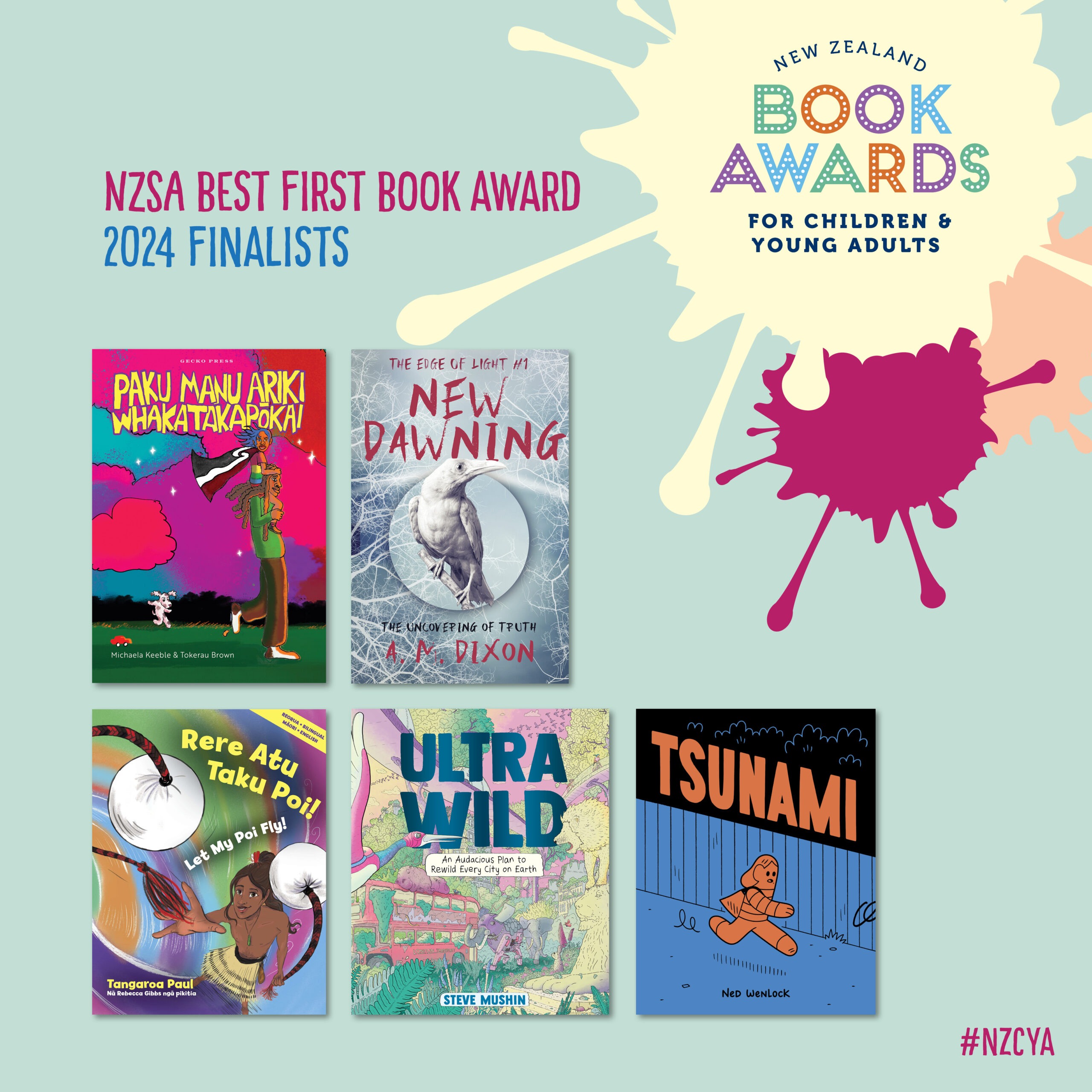
Best First Book is a difficult category because it encompasses such different types of books (although, to be fair, this is kind of true for every category). Here we have two picture books, a middle grade illustrated non-fiction, a YA novel, and a YA graphic novel. Paku Manu Ariki Whakatakapōkai is so different from other picture books; it’s an earnest and potted perspective of a child, dancing from one idea to the next in a way that is somehow both light and deep. Rere Atu Taku Poi! is a bright and inspiring story for performers and gender-non-conforming kids, something so needed in our kids’ books. Ultrawild is a series of audacious thought experiments about rewilding the planet in the face of climate change, in a jam-packed large format hardback. New Dawning is a post-apocalyptic novel set in climate-ravaged Aotearoa, the first in a series, and Tsunami is a very New Zealand coming-of-age story which is every bit as bleak as that sounds, in a good way.
I think Paku Manu Ariki Whakatakapōkai, Rere Atu Taku Poi!, and Ultrawild have the freshest feel, things we haven’t really seen in Aotearoa publishing. And Ned Wenlock has such a large body of work it’s hard to believe Tsunami is his first traditionally published title. I think I have to cheat and make two picks for winners: Ultrawild for its uniqueness and immaculate design and illustration, and Tsunami for its adept portrayal of character and story all in black and white.

Linda Jane is a writer of picture books, poetry, essays and science. Her background is varied, including work in ecology, environmental education, summer camps, and a community newspaper. She is Singaporean-Pākehā, queer, and loves leaping into cold bodies of water. She was previously lead editor for The Sapling.



